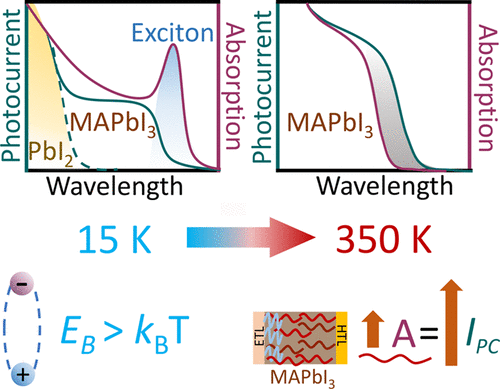当前位置:
X-MOL 学术
›
J. Phys. Chem. Lett.
›
论文详情
Our official English website, www.x-mol.net, welcomes your
feedback! (Note: you will need to create a separate account there.)
Photocurrent Spectroscopy of Perovskite Solar Cells Over a Wide Temperature Range from 15 to 350 K
The Journal of Physical Chemistry Letters ( IF 4.8 ) Pub Date : 2017-12-29 00:00:00 , DOI: 10.1021/acs.jpclett.7b02935 Jay B. Patel 1 , Qianqian Lin 1 , Olga Zadvorna 1 , Christopher L. Davies 1 , Laura M. Herz 1 , Michael B. Johnston 1
The Journal of Physical Chemistry Letters ( IF 4.8 ) Pub Date : 2017-12-29 00:00:00 , DOI: 10.1021/acs.jpclett.7b02935 Jay B. Patel 1 , Qianqian Lin 1 , Olga Zadvorna 1 , Christopher L. Davies 1 , Laura M. Herz 1 , Michael B. Johnston 1
Affiliation

|
Solar cells based on metal halide perovskite thin films show great promise for energy generation in a range of environments from terrestrial installations to space applications. Here we assess the device characteristics of the prototypical perovskite solar cells based on methylammonium lead triiodide (CH3NH3PbI3) over a broad temperature range from 15 to 350 K (−258 to 77 °C). For these devices, we observe a peak in the short-circuit current density and open-circuit voltage at 200 K (−73 °C) with decent operation maintained up to 350 K. We identify the clear signature of crystalline PbI2 contributing directly to the low-temperature photocurrent spectra, showing that PbI2 plays an active role (beyond passivation) in CH3NH3PbI3 solar cells. Finally we observe a blue-shift in the photocurrent spectrum with respect to the absorption spectrum at low temperature (15 K), allowing us to extract a lower limit on the exciton binding energy of 9.1 meV for CH3NH3PbI3.
中文翻译:

钙钛矿型太阳能电池在15至350 K的宽温度范围内的光电流光谱
基于金属卤化物钙钛矿薄膜的太阳能电池在从地面安装到太空应用的各种环境中显示出巨大的能量产生前景。在这里,我们评估了基于甲基铵三碘化铅(CH 3 NH 3 PbI 3)的典型钙钛矿型太阳能电池的器件特性,其温度范围为15至350 K(-258至77°C)。对于这些器件,我们在200 K(-73°C)的情况下观察到短路电流密度和开路电压的峰值,同时保持高达350 K的体面运行。我们确定了晶状PbI 2的清晰特征直接有助于低温光电流谱,表明PbI 2在CH 3 NH 3 PbI 3太阳能电池中发挥着积极的作用(超越钝化作用)。最后,我们观察到相对于低温(15 K)时的吸收光谱,光电流谱中出现蓝移,这使我们可以提取出对CH 3 NH 3 PbI 3的激子结合能为9.1 meV的下限。
更新日期:2017-12-29
中文翻译:

钙钛矿型太阳能电池在15至350 K的宽温度范围内的光电流光谱
基于金属卤化物钙钛矿薄膜的太阳能电池在从地面安装到太空应用的各种环境中显示出巨大的能量产生前景。在这里,我们评估了基于甲基铵三碘化铅(CH 3 NH 3 PbI 3)的典型钙钛矿型太阳能电池的器件特性,其温度范围为15至350 K(-258至77°C)。对于这些器件,我们在200 K(-73°C)的情况下观察到短路电流密度和开路电压的峰值,同时保持高达350 K的体面运行。我们确定了晶状PbI 2的清晰特征直接有助于低温光电流谱,表明PbI 2在CH 3 NH 3 PbI 3太阳能电池中发挥着积极的作用(超越钝化作用)。最后,我们观察到相对于低温(15 K)时的吸收光谱,光电流谱中出现蓝移,这使我们可以提取出对CH 3 NH 3 PbI 3的激子结合能为9.1 meV的下限。











































 京公网安备 11010802027423号
京公网安备 11010802027423号